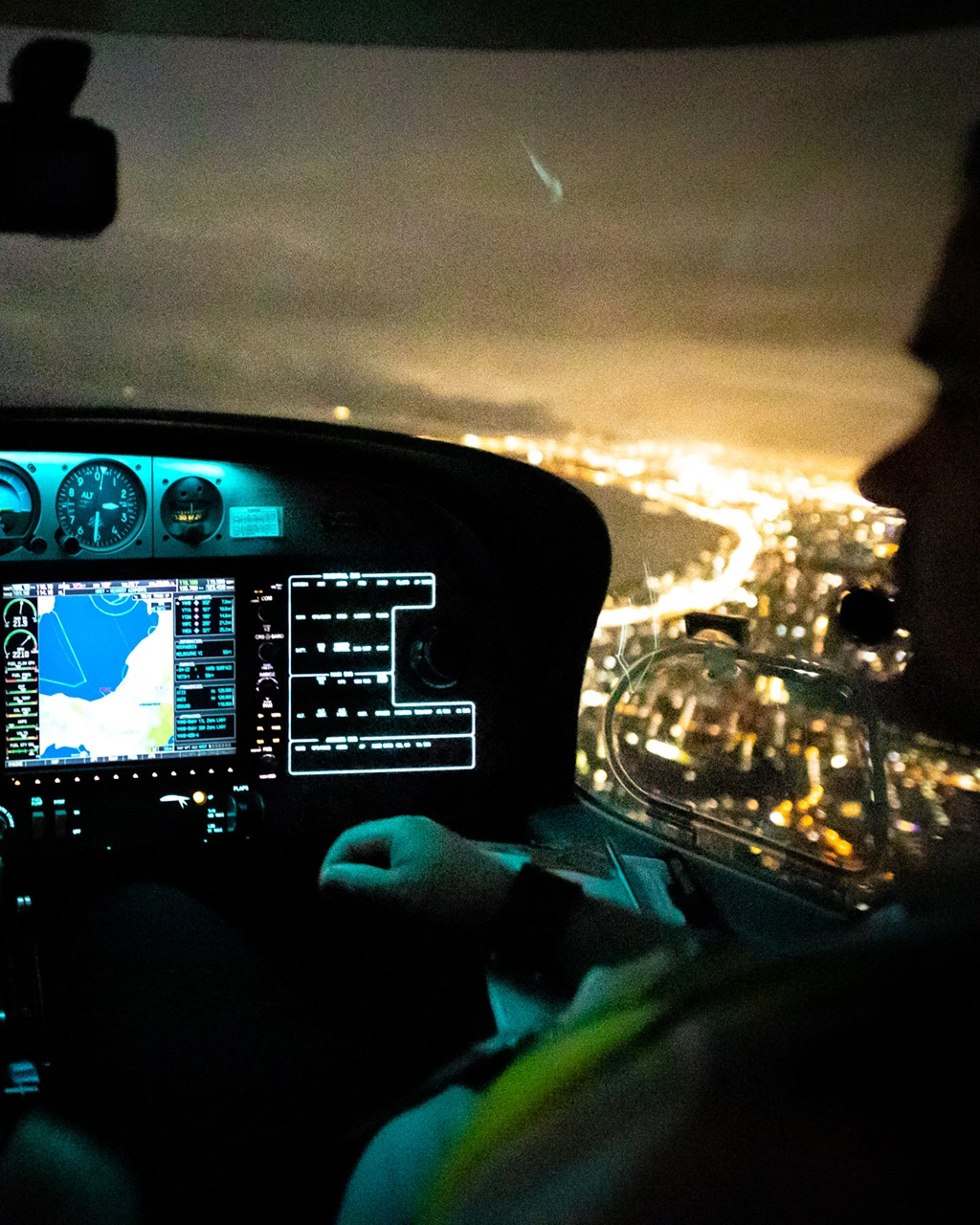
May 11, 2022
Flying at Night – Should You Get a Night VFR Rating?
Flying at night is a fantastic experience. Seeing a sprawling ocean of twinkling lights below is quite spectacular, especially if you live in a big city like Melbourne. To be able fly at night, you need to undergo specific training that must be done on top of your standard pilot licence, be that a Private Pilot Licence or Commercial Pilot Licence. There are 2 pathways you can take – the Night Visual Flight Rules (NVFR) pathway or the Instrument Flight Rules (IFR) pathway.
As a leading Australian flight school, Learn to Fly offers a huge range of pilot training courses, including the popular Night VFR Rating, as well as Instrument Rating courses.
Night VFR vs. IFR
The VFR in Night VFR stands for Visual Flight Rules which is a category of flying where flights can occur in meteorological conditions that are clear enough to see in. As a basic guide, pilots must have visual cues available to them during VFR flight.
IFR stands for Instrument Flight Rules. When weather conditions are not appropriate for flying by sight (ie thick clouds), flights may only be able to proceed under IFR. During IFR flights, a pilot relies on their instrumentation rather than visual cues.
Night VFR, therefore, refers to conditions in which a pilot can still have enough visual cues present even though it is dark. Night VFR is generally less common than Night IFR due to the combined added complexities associated with both flying at night and flying VFR. In fact, in CASA’s own words:
“CASA strongly recommends that NVFR operations take place only in conditions that allow the pilot to discern a natural visual horizon or where the external environment has sufficient cues for the pilot to continually determine the pitch and roll attitude of the aircraft”
Which pathway should you choose?
The pathway you choose should ultimately depend on the type of flying you are intending to do in the future. However, Night VFR training is a lot more straightforward than completing an Instrument Rating, so this may be a consideration.
There are a couple of options for an Instrument Rating. A Private Instrument Flying Rating (PIFR) is a course that you can tailor to the types of instrument flying you want to do. A Multi-Engine Command Instrument Rating (MECIR) covers all instrument flying, and also then allows you to fly aircraft with more than one engine.
Instrument Ratings also require all pilots to successfully complete the CASA Instrument Rating Exam (more commonly known as IREX).
Night VFR training is simpler and less costly. However, relying solely on VFR conditions will restrict the number of night time flying opportunities. In addition, the Instrument Rating itself obviously adds to the amount of daytime conditions you can fly in as well!
What to expect when flying at night
Before taking your first night flight, whether you’re in charge of the cockpit or simply accompanying a more experienced pilot, it’s a good idea to read up on what to expect. Firstly, it is worth noting that your aircraft must be adequately fitted in order to fly at night. This is the case regardless of whether the flight is under Night VFR or IFR rules. CASA strictly regulates this, with a number of lights (internal and external), radio equipment, and navigational aids required.
Be aware that it can take up to 30 minutes for your eyes to fully adjust to your surroundings. Before and during this time, it’s important that lighting inside the cockpit remains at an appropriate level. Red cockpit lighting can also help in this regard.
Similar to day flying day flying, the types of conditions you can expect when flying at night will vary dramatically. There may be situations where you are fortunate enough to have a full, unobscured moon to guide you. From a visual perspective, flying in these conditions may not be too different from flying during the day. Cloud cover may mean that your view below is obscured completely – this would obviously be considered an IFR flight. Pilots should always be aware of the conditions they are flying in but this is even more important at night.
Whilst somewhat uncommon, pilots flying at night do sometimes experience what are known as night flying illusions. Autokinesis, the black hole effect, flicker vertigo, false horizons, and sloping terrain illusions are all common illusions that pilots, both beginner and experienced, need to watch out for.
Night flying courses
Check out the links below to find out more about our night flying courses:
Private Instrument Flying Rating (PIFR)
Multi-Engine Command Instrument Rating (MECIR)
Flight Instructors can also complete a Night VFR Training Endorsement, that allows them to teach the Night VFR Rating course syllabus to students.
If you would like to find out more, you can email our flight training specialists at [email protected]. You can also visit https://drift.me/learntofly/meeting to book a meeting and school tour.








